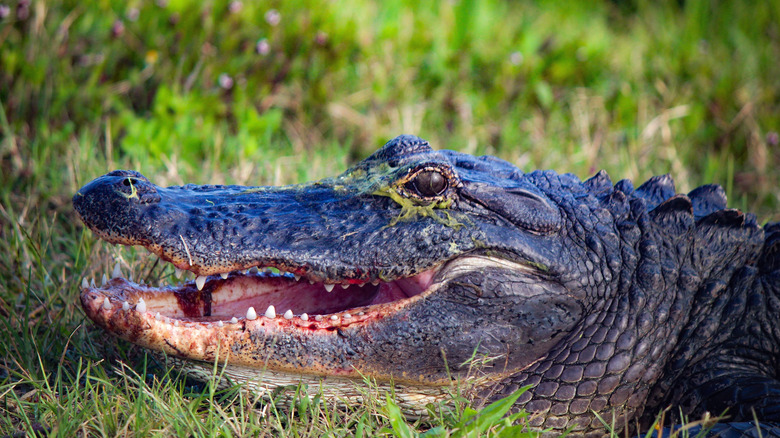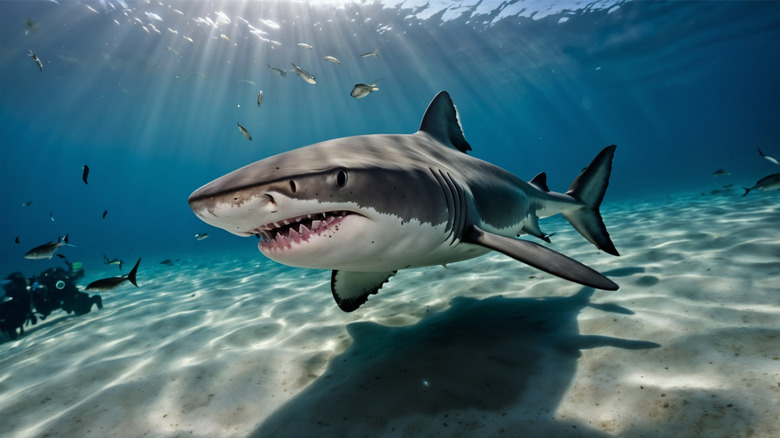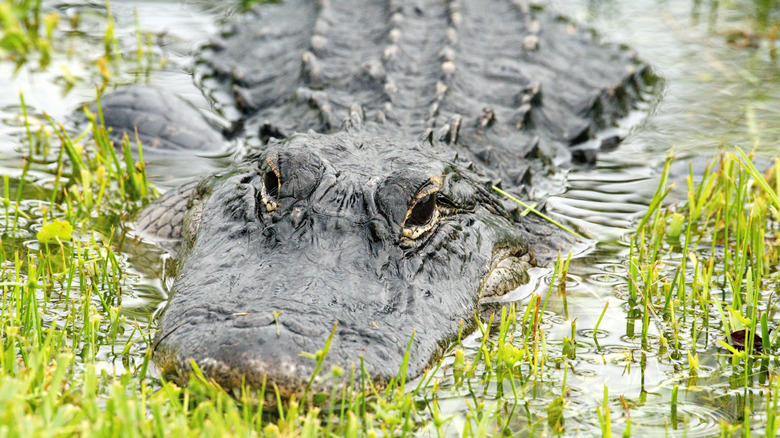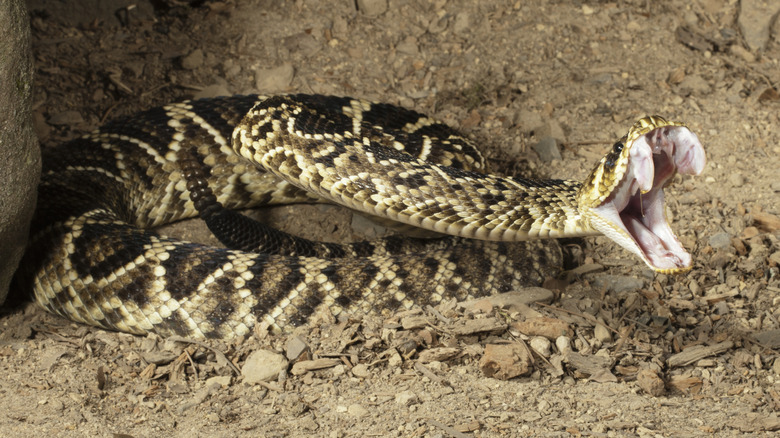Top 5 Most Dangerous Species In Florida
The United States is home to a surprising number of deadly animals. From dangerous spiders in North Carolina to aggressive snakes in Texas, the country is inhabited by numerous animals that pose a serious risk to humans. None of that should be too surprising considering the biodiversity of the U.S., which is home to more 32,000 animal species.
While some parts of the country remain relatively safe in terms of wildlife, there are numerous states that contain large amounts of dangerous animals. Texas typically comes out on top as one of the most dangerous states for attacks by wildlife on humans, but Florida usually isn't far behind. The Sunshine State remains one of the most biodiverse states in the Union, and it's home to at least 4,368 animal species and 3,038 plant species. Of course, not all of those animal species are harmless. In fact, Florida has an alarming number of dangerous animals across its more than 80 distinct ecosystems, and it's not just alligators. From sharks to snakes and even jellyfish, Florida is positively swarming with dangerous species, and these are the top five.
Burmese python
The Burmese python is not native to Florida, but this nonvenomous constrictor has certainly made the southern regions of the state its home. Originally brought into Florida in the '90s during a time when Burmese pythons were sought-after pets, the snakes quickly found their way into the wild, either by escaping or by being released by careless owners. As the USGS notes, it is not known just how many of the pythons exist in the wilds of Florida today, but due to their ability to survive in a range of habitats, tens of thousands are thought to inhabit the state.
While Florida is home to a number of dangerous snakes, there is something uniquely menacing about the Burmese python. Aside from the fact it is one of the most concerning invasive species in the country, the pythons' possess numerous characteristics that make them extremely dangerous. Rather than using venom to paralyze victims, the snakes simply sink their teeth into prey and then squeeze until their victim suffocates. Making the whole process even more upsetting is the fact that the snakes know when to stop squeezing due to the fact they are wrapped around their prey and can feel their heartbeat stop.
As if that wasn't nightmarish enough, Burmese pythons have stretchy skin between their lower jaws, which means they're able to devour prey equivalent to 100% of their body mass. You've likely seen images of these insidious reptiles devouring deer and other large animals whole, but Burmese pythons have also been found with the remains of entire alligators inside their stomachs. So, if you wondered whether Burmese pythons were really all that dangerous, just consider the fact that they can eat one of Florida's most dangerous predators whole.
Great white shark
The waters around Florida are actually home to a variety of sharks, with the Bull shark being one of the most deadly examples. But even more terrifying than this already lethal species is the great white shark. One of many sea species in the Gulf of Mexico, great whites have frequently been spotted off the Florida coast, with eight of the deadly creatures identified between February 1 and March 6, 2024, and in July of 2024, a massive 13-foot, 1,437-pound specimen was spotted off the Palm Beach County coast.
While the chances of being involved in a great white attack remain slim, there's absolutely no doubt that these sharks are the most dangerous of all shark species. Their torpedo-shaped bodies means they can move at speeds of up to 25 miles an hour, which comes in handy when the creatures ram their prey before using their impressive teeth to finish the job. Great whites typically have around 50 so-called "active" teeth and an estimated 4,000 pounds of bite force per square inch.
The only good news is that great white sharks typically migrate north during summer, only returning south for the winter months in search of warmer waters. That will surely be little consolation to many, especially since Florida typically leads the U.S. in shark attacks. In 2023, there were 36 documented attacks in the country, 16 of which were in Florida — though none were fatal. What's more, between 1837 and the present, there have been 928 shark attacks in the Sunshine State, far more than the state with the second most attacks — Hawaii with 195. While great white sharks haven't bitten anyone in Florida since 1926, the species is by far the most lethal of all sharks in Florida's oceans and remains an apex predator.
American alligator
A native predator to Florida, the American alligator is probably the state's most famous dangerous animal. Though it can actually be found as far west as Oklahoma and east Texas and as far east as North Carolina, the American alligator has resided in Florida for centuries. Today, the animals are in all 67 counties of the state and are easily one of its most dangerous species.
American alligators are carnivorous apex predators. Their strong jaws can easily break bone, with the reptiles using their teeth to hold prey in place and, depending on its size, swallow their victims whole or shake them until they can extract smaller pieces of flesh. The animals have also been known to drag large prey underwater, and can spin their bodies in an attempt to tear off more flesh. While gators typically eat fish, birds, and certain mammals, there have been numerous attacks on humans in Florida — even just in 2024. In May 2024, there were a number of alligator attacks that had occurred across Florida in the space of two weeks or so. In June, a man was bitten while swimming in Lake Munroe, Florida, resulting in the amputation of his arm, and in September, a woman was attacked and bitten in the leg by a gator while walking her dog in North Fort Myers.
And if you're looking for some other numbers, while female alligators typically reach up to 10 feet long, males can exceed that, with the longest gator ever captured in Florida measuring well over 14 feet long. The heaviest gator ever found in the state weighed in at 1,043 pounds — not something anyone wants to encounter while taking their dog for a walk.
Eastern diamondback rattlesnake
As if dodging gators and steering clear of great white sharks wasn't enough to worry about, Florida is also home to many dangerous snakes. While the Burmese python is one of the most dangerous invasive snakes in the state, Florida also hosts numerous native species. Of the 44 snake species in the state, six are venomous, and the diamondback rattlesnake is one example. While most Florida snakes are harmless and actually help maintain the ecosystems by removing extra rodents, that doesn't mean you want to encounter the diamondback rattlesnake out in the wild.
One of the biggest and most lethal snakes in the Americas, diamondbacks can reach lengths of up to almost 8 feet, and weights of more than 35 pounds. They are identifiable by the black, brown, and cream diamond patterns on their backs and are found in every county in Florida, as well as on nearshore islands.
Unlike pythons, this species uses fangs filled with venom to incapacitate prey, and can strike up to two-thirds of its body length. The fangs can reach up to an inch long and deliver up to 450 mg of hemorrhagic venom which, aside from causing bleeding, can also lead to cardiac problems for its victims. Diamondbacks typically eat small mammals such as mice, rabbits, rats, and squirrels, and they usually won't attack humans unless provoked. However, if a human is bitten by one of these snakes, it's important for them to seek immediate medical attention. Diamondback bites have a fatality rate of between 10% and 20% if left untreated, making this a particularly deadly Florida inhabitant.
Box jellyfish
Back in 2009, a single box jellyfish — typically found in the Caribbean — was discovered in Florida's Lake Wyma. Since then, the species has become much more prevalent in the waters around the state, becoming well-established in the red mangroves near Boca Raton by 2012. There are more than 40 species of box jellyfish, but they typically have a translucent, cube-like body (hence the name) from which multiple tentacles hang. These tentacles are capable of stinging prey and eight of the 40 species of box jellyfish have caused deaths.
Though less venomous than their Australian counterparts, the box jellyfish found in and around Florida can still deliver a painful and potentially deadly sting, capable of causing cardiac arrhythmias and respiratory problems. Certain species deliver toxins so potent, they can cause human victims to go into shock or die of heart failure. Victims of box jellyfish stings experience pain for weeks after the event and can develop significant scarring. So, when swimmers aren't dodging bull sharks and great whites, they have to be extra careful not to get stung by some of the deadliest jellyfish known to man.





